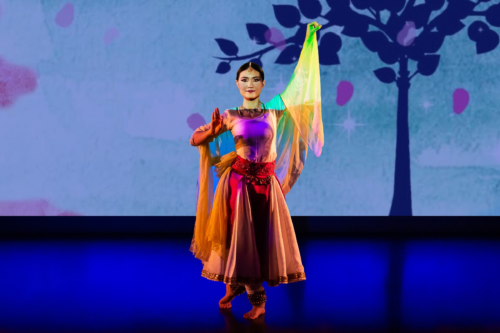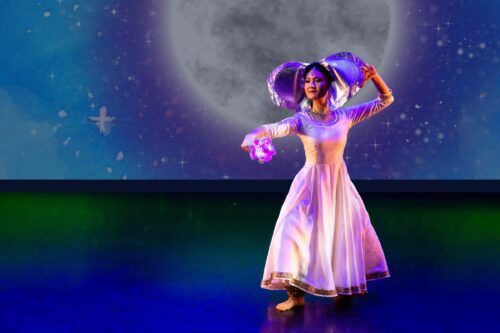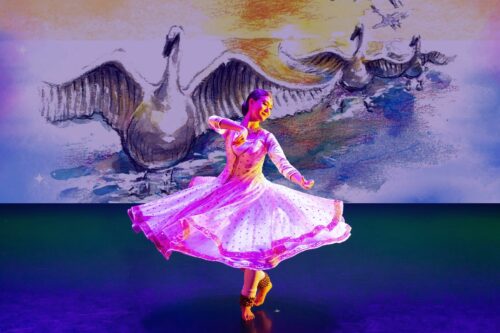Mimi diLuna Dances Tales of Siddhartha in Mind The Gap XXIV

Mind The Gap XXIV, March 28, 2023, had a unique lineup of dancers and choreographers. More than half of the pieces presented were of styles originating in India and Sri Lanka. It was a fitting context for Mimi diLuna’s two works, “Snowy-Silver Elephant” and “Hansadhwani: Voice of the Swan.” The two pieces are stories of Siddhartha, the prince who would eventually become known as the Buddha. diLuna, who is of French and Taiwanese descent, has trained in both classical Indian dance and ballet and while the costumes, stories, and indeed the bulk of the music and choreography show the Indian interests most strongly, ballet touches come through.
The pieces open with a projection on the upstage screen of a moon and stars with an elephant floating. Enter diLuna in silhouette wearing a headpiece that, when full lights come up onstage, is revealed to be elephant ears. The projections and costumes change as diLuna dances the story of Siddhartha’s mother learning she would bear a special child. This story feels the most abstract of the two episodes, though it may have been clearer to audience members who are more familiar with the gestures of classical Indian dance. There is a passage of Edvard Grieg’s “Morning Mood” played as part of the soundtrack, which somehow fit well among the other music (or maybe the Peer Gynt Suite is just a personal favorite and I latched onto the familiar). I mention the Indian gestures, but there were also gestures that looked to me like ballet pantomime. The opening of the hands slowly mirrored the lotus blossom projected on the screen, for example.

It is not clear to me when one story ended and another began. There were costume and projection and music changes throughout the first story to muddy those waters for me, but once we were solidly into the second story, the plot was more clear.
“Hansadhwani: Voice of the Swan” tells the story of Siddhartha’s cousin, Devadatta, shooting and wounding a swan. Siddhartha discovers the wounded bird and begins to nurse it back to health. Even though diLuna performs both characters, it is clear through her physical language when she switches between the two. The conflict of who has the right to the swan, the hunter or the caregiver, played out quite clearly to me. In this episode, ballet pantomime dominates for the storytelling without losing the Indian flavor of the choreography. We see the hunter shoot his bow, we see the healer apply salve to the swan. There is one more costume change after Siddhartha exits cradling the swan; diLuna returns to the stage with a sheer robe added to her costume and we see she has now transformed into the swan, which flies away, healed.

I cannot stress how much any misunderstanding I have of this work may be due to my own limited familiarity with Indian dance. I’ve watched many classical Indian performances over the years but I cannot say I’ve studied the form. I’m always taken by the colors, rhythms, and overall precision of the form and that was all on display in diLuna’s work, so if I lacked understanding, I nonetheless found plenty to enjoy.
Furthermore, I can’t help but believe that fans of classical story ballets might find much to enjoy in diLuna’s work. When it comes to ballet, I have to admit a preference for the contemporary abstract works, so I will also admit to maybe not being the best judge of this, but I will nonetheless recommend that fans of story ballets keep an eye out for the name Mimi diLuna. Her fusing of eastern and western sensibilities should find an audience among Houston dance watchers.



Recent Comments